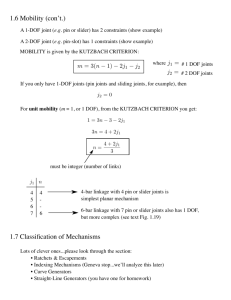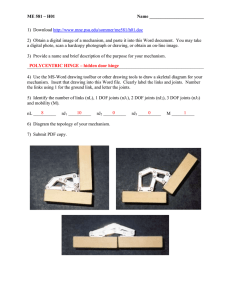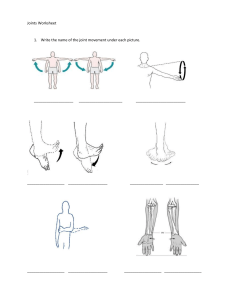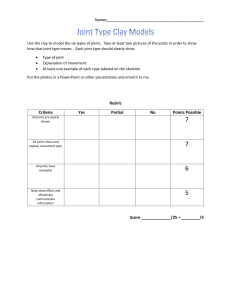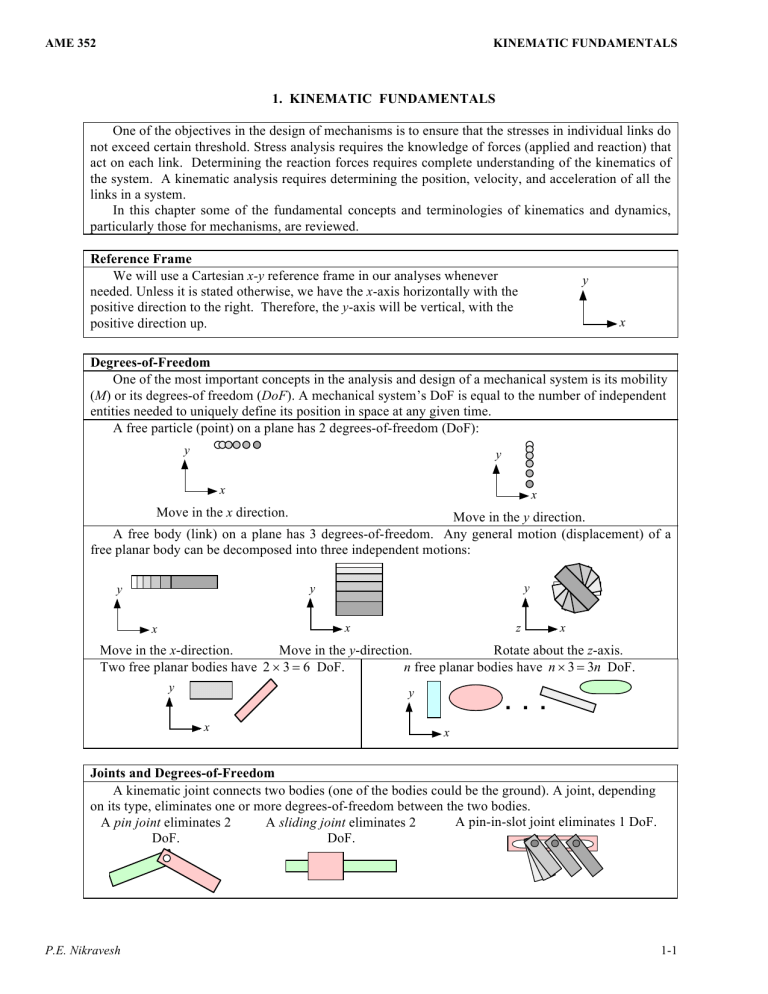
AME 352 KINEMATIC FUNDAMENTALS 1. KINEMATIC FUNDAMENTALS One of the objectives in the design of mechanisms is to ensure that the stresses in individual links do not exceed certain threshold. Stress analysis requires the knowledge of forces (applied and reaction) that act on each link. Determining the reaction forces requires complete understanding of the kinematics of the system. A kinematic analysis requires determining the position, velocity, and acceleration of all the links in a system. In this chapter some of the fundamental concepts and terminologies of kinematics and dynamics, particularly those for mechanisms, are reviewed. Reference Frame We will use a Cartesian x-y reference frame in our analyses whenever needed. Unless it is stated otherwise, we have the x-axis horizontally with the positive direction to the right. Therefore, the y-axis will be vertical, with the positive direction up. y x Degrees-of-Freedom One of the most important concepts in the analysis and design of a mechanical system is its mobility (M) or its degrees-of freedom (DoF). A mechanical system’s DoF is equal to the number of independent entities needed to uniquely define its position in space at any given time. A free particle (point) on a plane has 2 degrees-of-freedom (DoF): y y x x Move in the x direction. Move in the y direction. A free body (link) on a plane has 3 degrees-of-freedom. Any general motion (displacement) of a free planar body can be decomposed into three independent motions: y y y z x x x Move in the x-direction. Move in the y-direction. Rotate about the z-axis. n free planar bodies have n × 3 = 3n DoF. Two free planar bodies have 2 × 3 = 6 DoF. y ... y x x Joints and Degrees-of-Freedom A kinematic joint connects two bodies (one of the bodies could be the ground). A joint, depending on its type, eliminates one or more degrees-of-freedom between the two bodies. A pin-in-slot joint eliminates 1 DoF. A pin joint eliminates 2 A sliding joint eliminates 2 DoF. DoF. P.E. Nikravesh 1-1 AME 352 KINEMATIC FUNDAMENTALS • Joints that eliminate 2 DoF are called full joints. • Joints that eliminate 1 DoF are called half joints. Examples A double pendulum A single pendulum consists of 2 moving is composed of 1 bodies and 2 pin moving body pinned joints. The system has to the ground. The 2 DoF. system has 1 DoF. A triple pendulum consists of 3 moving bodies and 3 pin joints—it has 3 DoF. A four-bar mechanism consists of 3 moving bodies and 4 pin joints (2 of the bodies are pinned to the ground). The mechanism has 1 DoF. Mobility Formula The mobility formula can help us determine the number of degrees of freedom for most planar systems: M = 3 × Bmoving − 2 × J full − J half where, M is the mobility or the number of DoF; Bmoving is the number of moving bodies; J full is the number of full joints; and J half is the number of half joints. Examples Triple pendulum Six-bar mechanism A structure M = 3× 3− 2 × 3− 0 = 3 Slider-crank M = 3 × 3 − 2 × (3 + 1) − 0 = 1 P.E. Nikravesh M = 3 × 5 − 2 × (5 + 2) − 0 = 1 This system contains 4 links and 6 pin joints. M = 3× 4 − 2 × 6 − 0 = 0 Zero DoF means a structure (none of the links can move). 1-2 AME 352 KINEMATIC FUNDAMENTALS For some mechanisms the mobility formula fails to provide the correct number of DoF. For example, for the five-bar mechanism shown, there are 4 moving links and 6 pin joints, where the two side links are parallel and the other two links are parallel to the ground link. The mobility formula yields M = 3× 4 − 2 × 6 − 0 = 0 However, it should be clear from the illustration that the system has 1 DoF—this system is not a structure! The reason for the failure of the mobility formula in this case is the redundancy due the fact that the parallel links are equal in length and remain parallel. Note: If a pin joint is connecting 3 links, the number of pin joints must be counted as 2. In general, if a pin joint connects n links, we must count that as n − 1 pin joints in the mobility formula. Planar Mechanisms A planar mechanism is a mechanical system that contains more than one moving link, more than one joint, and the links move in parallel planes. Slightly different definitions for a mechanism may be found in literature. In this course we accept the following criteria as a definition for a mechanism: • A mechanism has only one degree of freedom. This definition enforces a condition that the links and the joints in a mechanism to form one or more closed kinematic chains (loops). (The definition of kinematic chains will be given in the upcoming chapters). Therefore, by this definition a pendulum is not a mechanism. • A mechanism may contain only pin and sliding joints (this also include the combine pin-in-slot joint). By this definition, systems containing cam-followers or gears are not mechanisms. Four-bar Mechanisms Four-bars are the most commonly used mechanisms. We adopt the following numbering system for the links: Link (1) is the ground (frame or base) which is non-moving (3) in most applications. (4) Link (2) is the input link. (2) Link (3) is called the coupler which could be the output link in a few applications. (1) Link (4) is called the follower and in most application it is the output link. Please note that in most drawings of fourbars the ground link is not shown as a link as appears in this figure. Four-bar Mechanisms—Grashof Condition In most applications of four-bar mechanisms, a rotary motor is used about the axis of one of the pin joints to rotate one of the links continuously. Therefore it is crucial to know which of the links can make a full 360 rotation. Grashof condition is a simple test to determine that at least one of the links can be rotated with a rotary input (motor). Measure the length of the four links: P.E. Nikravesh 1-3 AME 352 KINEMATIC FUNDAMENTALS S : denotes the length of the shortest link; L : denotes the length of the longest link; P and Q : denote the lengths of the other two links. The four-bar is Grashof if S + L≤ P+Q This means that at least one of the links can go through a complete rotation; i.e., 360o . The four-bar is non-Grashof if S + L> P+Q This means that none of the links can rotate completely. Inversions of A Grashof Four-bar A four-bar mechanism has four inversions depending on which of the links is fixed to the ground. Although the link lengths do not change between inversions, the motion of the four-bars to an observer standing on the ground (attached to the fixed link) appears to be very different. Inversion 1: Inversion 2: motor ground link ground link motor Inversion 4: Inversion 3: motor motor ground link ground link Inversions of A Non-Grashof Four-bar A non-Grashof four-bar also has four inversions. Note that none of the links can go through a complete rotation. P.E. Nikravesh 1-4 AME 352 KINEMATIC FUNDAMENTALS Inversion 2: Inversion 1: ground link Inversion 3: ground link Inversion 4: ground link ground link Slider-Crank Mechanisms A slider-crank is a four-bar where one of the pin joints is replaced by a sliding joint. The numbering system of the links is similar to a four-bar mechanism. The non-moving link may not be shown in a figure. If link (2) is the input link and (4), the slider, is the output link, the mechanism may be referred to as a “crank-slider”, but if the slider is the input link and link (2) is the output, such as in an internal combustion engine, the mechanism is referred to as a “slider-crank”. In our discussion, regardless of the input and output links, we will refer to this type of mechanism as a slider-cranks. (3) (3) (2) (2) (4) (4) (1) P.E. Nikravesh (1) 1-5 AME 352 KINEMATIC FUNDAMENTALS Inversions of A Slider-crank A slider-crank similar to a four-bar has four inversions. Inversion 1: Inversion 2: ground link ground link Inversion 3: Inversion 4: this link rotates with the block ground link ground link Toggle Position When two links of a mechanism become collinear (forming a straight line), the links are said to be in toggle. We consider a four-bar mechanism as an example. (3) (4) (2) (1) Links (2) and (3) are in toggle (2 cases): (3) (3) (2) (2) Links (2) and (1) are in toggle (2 cases): (2) P.E. Nikravesh (1) (2) (1) 1-6 AME 352 KINEMATIC FUNDAMENTALS Transmission Angle In a four-bar mechanism if link (2) is the input (driver) link and link (4) is the output link, then the angle between link (3) (the coupler) and the output link is called the transmission angle, μ . This angle is measured as the smaller angle between the two links; i.e., μ ≤ 90 o . Therefore the optimal transmission angle is μ = 90 o . μ (3) μ (3) (4) (4) (2) (1) (1) (2) μ In a slider-crank mechanism, if the slider is the input link, then the angle between the other two links is the transmission angle. In an internal combustion engine, in one complete cycle, the transmission angle becomes 0 o twice and 90 o twice. P.E. Nikravesh (3) input link (4) output link (2) 1-7

